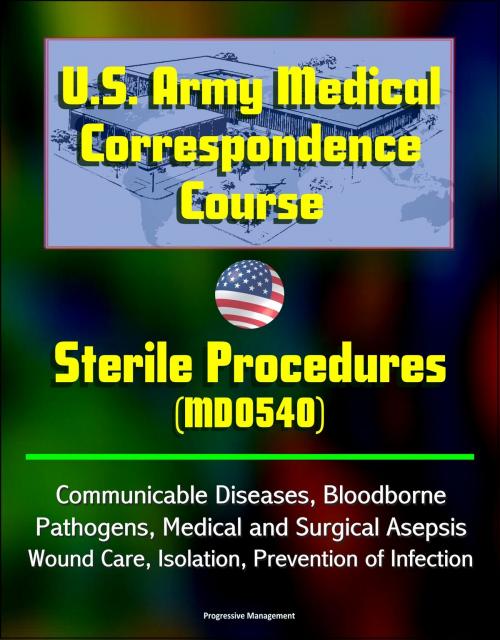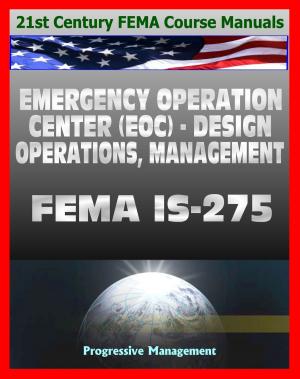U.S. Army Medical Correspondence Course: Sterile Procedures (MD0540) - Communicable Diseases, Bloodborne Pathogens, Medical and Surgical Asepsis, Wound Care, Isolation, Prevention of Infection
Nonfiction, Health & Well Being, Medical, Specialties, Critical Care, Ailments & Diseases, Infectious Diseases, General| Author: | Progressive Management | ISBN: | 9781311515780 |
| Publisher: | Progressive Management | Publication: | October 12, 2014 |
| Imprint: | Smashwords Edition | Language: | English |
| Author: | Progressive Management |
| ISBN: | 9781311515780 |
| Publisher: | Progressive Management |
| Publication: | October 12, 2014 |
| Imprint: | Smashwords Edition |
| Language: | English |
A cardinal rule in the medical field is to not do more harm than good to the casualty. This is the reason we must be careful to protect the patient from infection or disease while attempting to treat him. There are times in combat situations when you may not have the time to wash your hands or to wear gloves and mask as you work with the casualty. This is understandable. You must work quickly to help the casualty.
This subcourse discusses communicable diseases and how they are transmitted, medical asepsis, surgical asepsis, the purposes of dressings, types of dressing materials, how to change a sterile dressing, and how to irrigate a wound.
This subcourse is approved for resident and correspondence course instruction. It reflects the current thought of the Academy of Health Sciences and conforms to printed Department of the Army doctrine as closely as currently possible.
INTRODUCTION * LESSON 1 - COMMUNICABLE DISEASES * Section I. Review * Section II. Prevention and Control of Infection * Section III. Bloodborne Pathogens * Exercises * LESSON 2 - MEDICAL ASEPSIS * Exercises * LESSON 3 - SURGICAL ASEPSIS AND STERILE TECHNIQUE * Exercises * LESSON 4 - PROCEDURES USED IN WOUND CARE * Section I. Changing a Sterile Dressing * Section II. Wound Irrigation * Section III. Preparing a Wound for Operative Treatment * Exercises * LESSON 5 - ISOLATION * Section I. Types of Isolation * Section II. Isolation Techniques * Exercises
Infections are prone to develop in wounds of violence. Therefore, the prevention and control of infection is one of the chief problems in emergency medical treatment and care of wounded patients. The development of infection, particularly in large wounds, increases the period of morbidity since infection produces further destruction of tissue and suppresses the healing process. Infection also has a marked effect on the final result of the injury and the mortality. Tissues destroyed by infection are usually replaced by scar tissue, which may have a harmful effect on function as well as appearance.
A cardinal rule in the medical field is to not do more harm than good to the casualty. This is the reason we must be careful to protect the patient from infection or disease while attempting to treat him. There are times in combat situations when you may not have the time to wash your hands or to wear gloves and mask as you work with the casualty. This is understandable. You must work quickly to help the casualty.
This subcourse discusses communicable diseases and how they are transmitted, medical asepsis, surgical asepsis, the purposes of dressings, types of dressing materials, how to change a sterile dressing, and how to irrigate a wound.
This subcourse is approved for resident and correspondence course instruction. It reflects the current thought of the Academy of Health Sciences and conforms to printed Department of the Army doctrine as closely as currently possible.
INTRODUCTION * LESSON 1 - COMMUNICABLE DISEASES * Section I. Review * Section II. Prevention and Control of Infection * Section III. Bloodborne Pathogens * Exercises * LESSON 2 - MEDICAL ASEPSIS * Exercises * LESSON 3 - SURGICAL ASEPSIS AND STERILE TECHNIQUE * Exercises * LESSON 4 - PROCEDURES USED IN WOUND CARE * Section I. Changing a Sterile Dressing * Section II. Wound Irrigation * Section III. Preparing a Wound for Operative Treatment * Exercises * LESSON 5 - ISOLATION * Section I. Types of Isolation * Section II. Isolation Techniques * Exercises
Infections are prone to develop in wounds of violence. Therefore, the prevention and control of infection is one of the chief problems in emergency medical treatment and care of wounded patients. The development of infection, particularly in large wounds, increases the period of morbidity since infection produces further destruction of tissue and suppresses the healing process. Infection also has a marked effect on the final result of the injury and the mortality. Tissues destroyed by infection are usually replaced by scar tissue, which may have a harmful effect on function as well as appearance.















